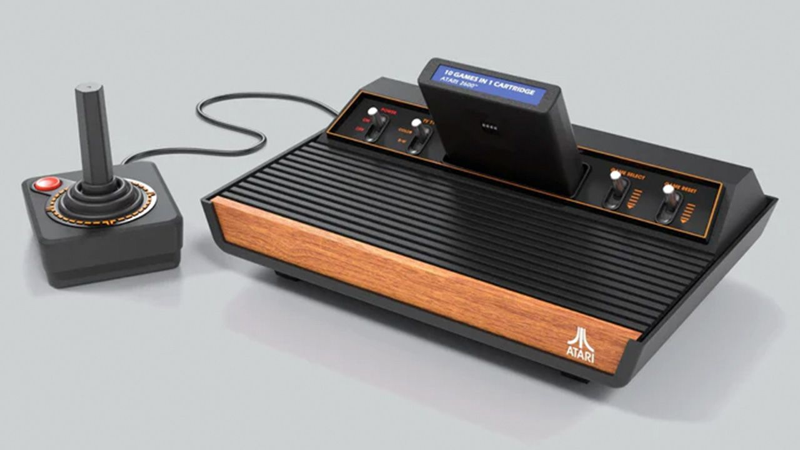What Will Be The Next 'Evolution' In Video Gaming?
Image Source: CultureSlate
From the simplistic gameplay and minimalist graphics of the Atari 2600 to the realistic physics of the Source engine, video games have always been looking for ways to improve themselves. Like any other innovation, there can be multiple ways to branch off just how the technology can be molded, and depending on who you go to, it can lead to fascinating results. With video games being as popular as they are, it seems only natural that enthusiasts, programmers, and designers would look for ways to 'evolve' the concept of what a video game can do.
What does 'evolution' entail? Well, many who were alive during this 'era' of gaming may hold a certain bitter-sweet nostalgia for what many describe as the "Console Wars". While this is but one example of how gaming can 'evolve', it's one of the easiest ways to see what companies were doing to market their gaming consoles above the rest. Even before the infamous "Video Game Crash of '83" (humorously known as the "Atari shock" in Japan), video game companies were doing everything they could to create newer games with more stylized graphics and intricate gameplay. The concept of being able to play a video game on a home console was quite a novel one in the 70's.
RELATED:
Image Source: CNN
What started with something as simple as the Magnavox Odyssey and the Atari 2600 soon turned into a sort of 'turf war' for the video game market between Nintendo and SEGA (with an honorable mention to Atari). While gameplay was an important element in their games, what usually sold people on the SNES or the Genesis/Megadrive (for you Europeans out there) was the graphics and the mascots associated with the companies. While some gamers would prefer the colorful, expansive platforming of Super Mario World or Donkey Kong Country, others may prefer the gritty, fast processing power provided for games such as Sonic the Hedgehog or Gunstar Heroes.
Just because Nintendo and SEGA had a major hand in evolving how games are enjoyed, it doesn't mean there weren't any hang-ups in the ever-expanding battle of one-upmanship. More concepts were played with for newer consoles with hopes of 'leveling up' gaming also. While the SEGA CD and the Virtual Boy had boasted technological advances, gamers were quick to realize many of the games these consoles played were anything but an “advancement”. It appears that gameplay has always had precedence over gimmicks or graphics.
But these are consoles of the past, man! What about the incredible leaps of gaming evolution we’ve had since then? Who could forget the immense popularity the Nintendo Wii garnered when it was first marketed in the early 2000s? It was the first time many gamers had seen non-conventional motion controls, often used in multiple ways. With such a big step forward in console “evolution”, Microsoft’s Kinect and Sony’s PS Move weren’t far behind, hoping to cash in on what appeared to be the hottest trend. While the Wii remains a popular entry to Nintendo’s console line, most tend to choose to forget that the Kinect was ever a product, due to shoddier motion controls, as well as a lack of titles for the system. While Nintendo continued to try out new things with their consoles, with releases such as the Wii U and the Switch, Microsoft and Sony decided to play it simple. For a while, at least.
Even if the Virtual Boy didn't live up to expectations gamers had for "virtual reality", that didn't mean the technology wasn't touched upon later. For example, Sony has the Playstation VR for use on the PS4/PS5, though brands such as the Valve Index, the HTC VIVE, and the Meta Quest 3 are also popular choices—certainly a leap up from merely sitting on the couch with a simple controller. Now, with the various headsets, gamers can feel like they're in Five Nights at Freddie's and meet up with their internet friends in VRChat, most likely dressed up as Sonic the Hedgehog, Kermit the Frog, a giant talking building, or Jerma985. Valve's own Half-Life: Alyx goes to the next level with virtual reality, mixing story-telling with a fun physics engine and heart-racing FPS gameplay. It is a definite must-play for anyone with the Valve Index. With the power of virtual reality, transhumanism can become a reality!
Image Source: Road To VR
At the very least, it could. For every Half-Life: Alyx, there are at least a few games that are nothing more than comedic tech demos. While they may be fun to play and show off how innovative VR technology is, it doesn't have the same sort of longevity or gameplay that other titles can have. Even if most of them tend to be ports of previously released titles (such as Skyrim, Fallout 4, or Borderlands 2). There is no crime in having different gameplay mechanics or themes, however. A larger variety helps add newer titles to an increasingly popular way to play, which brings in a bigger audience; if there's one thing game companies like, it's bringing in more people!
Naturally, video games are not just about the hardware. Over the years, more and more releases have been available for download only, with no physical disk or cartridge. There's certainly nothing wrong with this approach, as it can be quite costly to produce physical copies of games. Despite the positives, though, negatives come into play with a few simple facts. For one, despite "triple A" releases having both physical and downloadable versions, the cost will almost always be the same. Secondly, a common occurrence that tends to draw the ire of many gamers is the inclusion of microtransactions. Perhaps the most egregious example as of late would be Capcom's Dragon's Dogma 2, which provided the player an opportunity to spend between $0.99 and $4.99 to receive consumables and in-game points... that the player could easily find in-game without needing to use real money. Fortunately, most gamers aren't so desperate to have to resort to such needs. After all, there are other in-game goodies to spend your paycheck!
Image Source: Epic Games
While Fortnite didn't invent the "Battle Royale" gaming genre, it certainly did popularize it, earning a player base in the millions. The game itself is free to play, though it doesn’t take long to see it advertise “battle passes” and player skins, all of which can only be purchased with real money. It clearly worked out for Epic Games, as it didn’t take long for other “triple A” companies to adopt the 'battle pass' method of microtransactions, looking to turn gaming into a “live service” angle to hook more players. With a never-ending loop of gameplay and a consistent stream of new content to sell, this way of gaming has shown that “evolution” can also benefit capitalism. What's the worst that can happen? The servers shut down years from now once profits take a dip, leading the higher-ups to take all of the money while the players lose everything they had grinded and paid for. That's just crazy!
So now leads to the reason why you probably clicked this article: what will the next evolution of gaming be? Well, much like an ever-expanding skill tree in an RPG game, it’s hard to say. Handheld consoles, virtual reality, and the oh-so-popular 'live-service' formula of video games may seem like an end-all, be-all sort of situation, but no one knows what the future has in store. With the concept of omnidirectional treadmills arising for VR usage, only time will tell just how the games stack up to the technological advancement. On one hand, it could usher in an era of FPS games that actually require the player to run and move their body, instead of just flicking joysticks and mashing buttons as if they had just injected pure caffeine into their veins. On the other, the cost of having a giant treadmill on top of a VR headset and whatever games require both innovations may prove to be too expensive for the average gamer.
At the end of the day, the best 'evolution' of gaming doesn't come from making the biggest, fanciest, most expensive toys that bring us one step closer to becoming one with the 'metaverse', or whatever you want to call it. Truthfully, most gamers just want to... play games! Innovations like the Steam Deck help make gaming more accessible to those who may not have the money (or space) for an entire computer set-up. The ability to have access to your entire Steam library on the go with little hindrance to performance is quite handy, especially when one's library is full of indie games that require little CPU output to begin with.
This leads to the final statement about how gaming will “evolve”. While there’s something impressive about incredibly detailed, realistic graphics and cinematic cutscenes and acting, there’s still a charm that gamers appreciate from indie games. Aside from not costing an arm and a leg, there’s less of a chance it could overheat your hard drive because of an overabundance of resources. Games such as Pizza Tower, Balatro, Another Crab’s Treasure, and Lethal Company are only a tiny amount of examples from a huge pool that prove that you don't need a monstrously huge budget or team to make high-quality games that are highly enjoyable. Who knows; maybe the next evolution of gaming will be major 'triple a' companies getting rid of crunch times and charging less for games that players will get to keep playing years from now. It may seem shockingly simple, but in essence, it's all gamers really want.
If Warframe and Dwarf Fortress can keep receiving updates and retaining a player base, then the potential is surely there for other video games. It just requires listening to said player base and not just listening to the amount of money jingling around in their bank accounts. Games are more than just how much money they're worth; they're fun, interactive pieces of art that should be accessible to everyone. The more developers and companies realize this, the better gaming will be in the future.
READ NEXT:

















